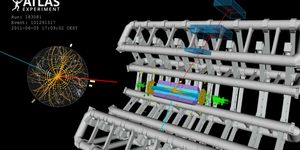New Blink Reflex Test Quickly Diagnoses Concussions
A new device called the Blink Reflexometer™ could drastically improve field-side diagnostic capabilities used by athletic trainers and medical staff in diagnosing athletes suspected of having a concussion. Developed by Nancey Tsai, MD, from the Medical University of South Carolina (MUSC), the new technology brings objectivity to a diagnostic field historically weighed down by misleading self-reporting and objective assessments of balance.
At least 25 percent of the nearly 4 million concussions estimated to occur in the United States by the Centers for Disease Control and Prevention (CDC) have contact sports to blame, experts say. Current diagnostic measures are severely lacking objectivity in their assessments, but the new Blink Reflexometer™ provides the opportunity to change everything.
The device works as a “high-speed, videography-based” technique for analyzing a person’s blink reflex, which researchers find reliable as a “primitive reflex.” After Tsai developed the Blink Reflexometer™, The Citadel’s Dena Garner, PhD, was eager to join the project.
"Concussion is a mild traumatic brain injury, and we know it's under-reported because, so often, it goes unnoticed or undiagnosed,” Garner explained. “The chance to test a piece of equipment that can be used field-side to assess concussions was especially compelling."
The device works like this. An individual suspected of having a concussion wears a mask that “delivers three to five air puffs at random intervals over 20 seconds” to the outer corner of the eye. The Blink Reflexometer™ records blink reflex at 280 frames/second, and specific frames isolated and analyzed.
"A human's blink reflex has a long pathway - originating at the facial area and continuing to the brain stem,” Garner explained. “If any place along that pathway is damaged, changes in the blink reflex can indicate that there is a potential problem.”
Tsai and Garner tested the the Blink Reflexometer™ by collecting blink reflex data in a study with 24 male football players between the ages of 18 and 22. The study participants were split into two groups: those who were suspected of experiencing a “concussive event” and those who were not, to serve as experimental and control groups. Researchers established baseline values for blink reflex parameters, athletic history, physical examination, balance parameters, and neurocognitive test scores.
A control group was particularly important in this study because normal blink reflex changes occur during active sports play even when a concussion is not involved. Researchers needed to be able to tell the difference between these normal changes and changes that implied an individual had experienced a concussion.
Ultimately, researchers were able to identify key differences between the control group and the potentially concussive group, including blink latency, lid velocity, and increase time for eyes to open.
"We now know that concussions and normal play both affect the blink parameters, but in differing directions,” Garner explained. “Our observations identified something distinctly different occurring in the concussion brains that can serve as a valuable new indicator for diagnosing the condition."
Going forward, Tsai, Garner, and other researchers plan on expanding the collection of blink reflex data to other age groups and sports. Someday soon, they hope to apply the capabilities of the Blink Reflexometer™ to neurological diseases like Parkinson’s and multiple sclerosis (MS).
The present study was published in the journal Cogent Engineering.









